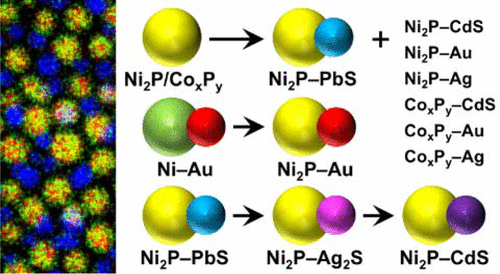当前位置:
X-MOL 学术
›
Inorg. Chem.
›
论文详情
Our official English website, www.x-mol.net, welcomes your
feedback! (Note: you will need to create a separate account there.)
Incorporation of Metal Phosphide Domains into Colloidal Hybrid Nanoparticles
Inorganic Chemistry ( IF 4.3 ) Pub Date : 2021-03-04 , DOI: 10.1021/acs.inorgchem.0c03826 Emil A. Hernández-Pagán 1, 2 , Robert W. Lord 1 , Joseph M. Veglak 1 , Raymond E. Schaak 1, 3, 4
Inorganic Chemistry ( IF 4.3 ) Pub Date : 2021-03-04 , DOI: 10.1021/acs.inorgchem.0c03826 Emil A. Hernández-Pagán 1, 2 , Robert W. Lord 1 , Joseph M. Veglak 1 , Raymond E. Schaak 1, 3, 4
Affiliation

|
Colloidal hybrid nanoparticles have generated considerable attention in the inorganic nanomaterials community. The combination of different materials within a single nanoparticle can lead to synergistic properties that can enable new properties, new applications, and the discovery of new phenomena. As such, methodologies for the synthesis of hybrid nanoparticles that integrate metal–metal, metal chalcogenide, metal oxide, and oxide–chalcogenide domains have been extensively reported in the literature. However, colloidal hybrid nanoparticles containing metal phosphide domains are rare, despite being attractive systems for their potentially unique catalytic, photocatalytic, and optoelectronic properties. In this Forum Article, we report a study of the synthesis of colloidal hybrid nanoparticles that couple the metal phosphides Ni2P and CoxPy with Au, Ag, PbS, and CdS using heterogeneous seeded-growth reactions. We also investigate the transformation of Au–Ni heterodimers to Au–Ni2P, where phosphidation of preformed metal–metal hybrid nanoparticles offers an alternative route to metal phosphide systems. We also study sequential cation-exchange reactions to target specific metal phosphide hybrids, i.e., the transformation of Ni2P–PbS into Ni2P–Ag2S and then Ni2P–CdS. Throughout all of these pathways, the accompanying discussion emphasizes the synthetic rationale, as well as the challenges in synthesis and characterization that are unique to these systems. In particular, the observation of oxide shells that surround the phosphide domains has implications for the potential photocatalytic applications of these hybrid nanoparticles.
中文翻译:

金属磷酸盐域掺入胶体杂化纳米粒子。
胶体杂化纳米颗粒在无机纳米材料界引起了相当大的关注。单个纳米粒子中不同材料的组合可以产生协同特性,从而可以实现新特性,新应用和发现新现象。因此,在文献中已广泛报道了整合金属-金属,金属硫属元素化物,金属氧化物和氧化物-硫属元素化物域的杂化纳米颗粒的合成方法。然而,尽管由于其潜在的独特催化,光催化和光电特性而成为有吸引力的系统,但包含金属磷化物域的胶体杂化纳米颗粒却很少。在此论坛文章中,我们报告了对金属磷化物Ni偶联的胶体杂化纳米颗粒的合成的研究2 P和Co x P y与Au,Ag,PbS和CdS结合使用非均一的种子生长反应。我们还研究了Au-Ni异二聚体向Au-Ni 2 P的转化,其中预先形成的金属-金属杂化纳米颗粒的磷化为金属磷化物系统提供了另一种途径。我们还研究了针对特定金属磷化物杂化体的顺序阳离子交换反应,即,将Ni 2 P–PbS转变为Ni 2 P–Ag 2 S,然后转变为Ni 2P–CdS。在所有这些途径中,伴随的讨论都强调了综合原理,以及这些系统独有的综合和表征挑战。特别地,观察到围绕磷化物域的氧化物壳对这些杂化纳米颗粒的潜在光催化应用具有影响。
更新日期:2021-04-05
中文翻译:

金属磷酸盐域掺入胶体杂化纳米粒子。
胶体杂化纳米颗粒在无机纳米材料界引起了相当大的关注。单个纳米粒子中不同材料的组合可以产生协同特性,从而可以实现新特性,新应用和发现新现象。因此,在文献中已广泛报道了整合金属-金属,金属硫属元素化物,金属氧化物和氧化物-硫属元素化物域的杂化纳米颗粒的合成方法。然而,尽管由于其潜在的独特催化,光催化和光电特性而成为有吸引力的系统,但包含金属磷化物域的胶体杂化纳米颗粒却很少。在此论坛文章中,我们报告了对金属磷化物Ni偶联的胶体杂化纳米颗粒的合成的研究2 P和Co x P y与Au,Ag,PbS和CdS结合使用非均一的种子生长反应。我们还研究了Au-Ni异二聚体向Au-Ni 2 P的转化,其中预先形成的金属-金属杂化纳米颗粒的磷化为金属磷化物系统提供了另一种途径。我们还研究了针对特定金属磷化物杂化体的顺序阳离子交换反应,即,将Ni 2 P–PbS转变为Ni 2 P–Ag 2 S,然后转变为Ni 2P–CdS。在所有这些途径中,伴随的讨论都强调了综合原理,以及这些系统独有的综合和表征挑战。特别地,观察到围绕磷化物域的氧化物壳对这些杂化纳米颗粒的潜在光催化应用具有影响。





















































 京公网安备 11010802027423号
京公网安备 11010802027423号